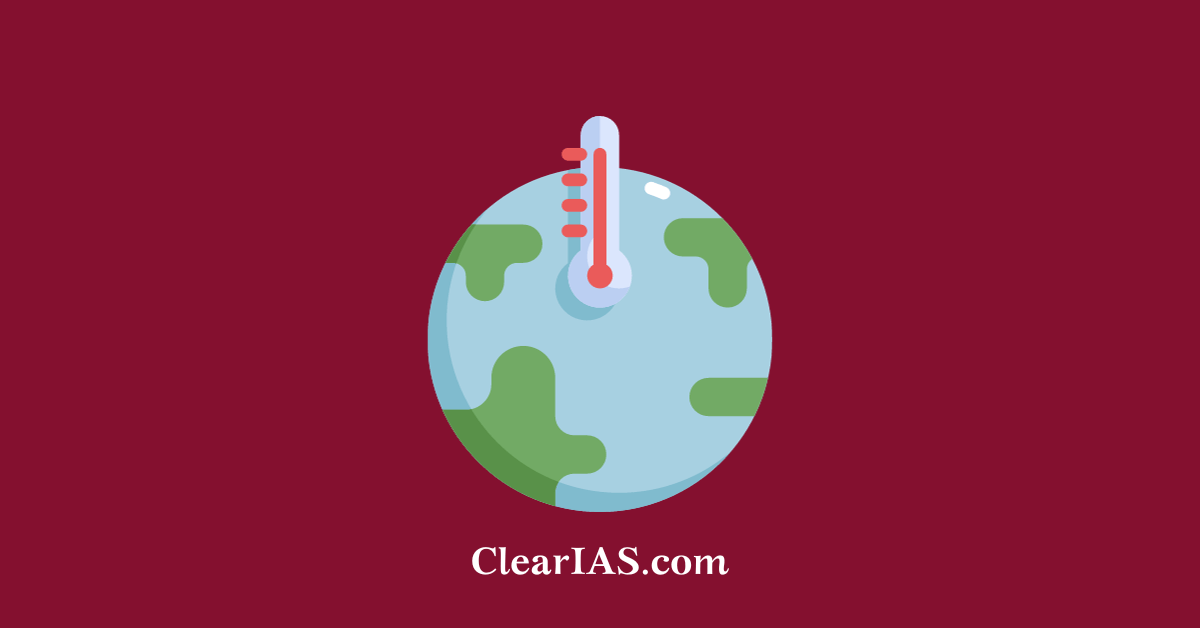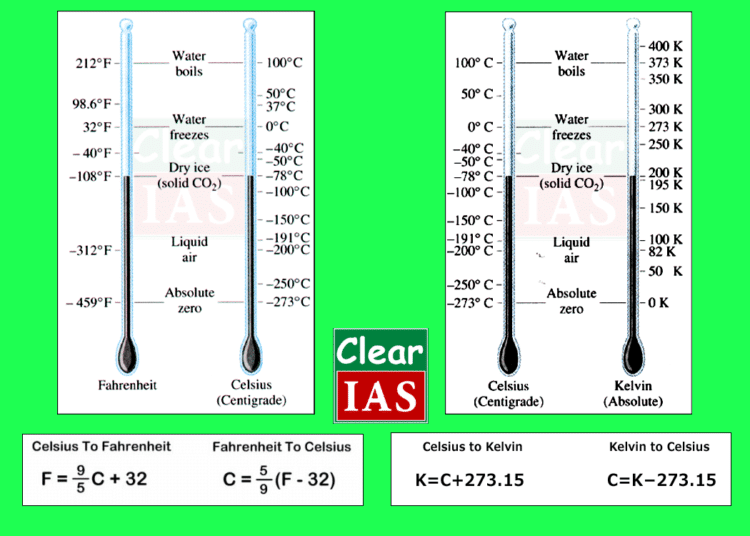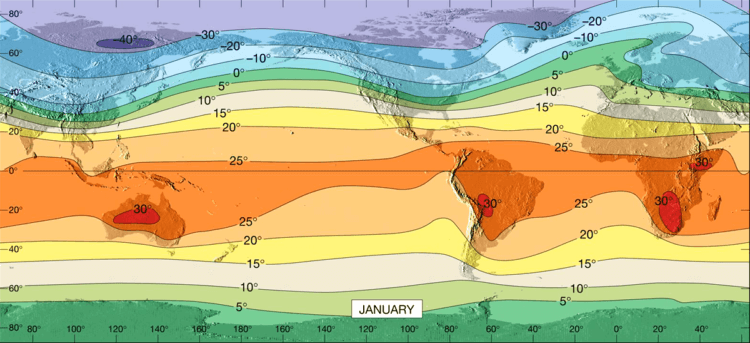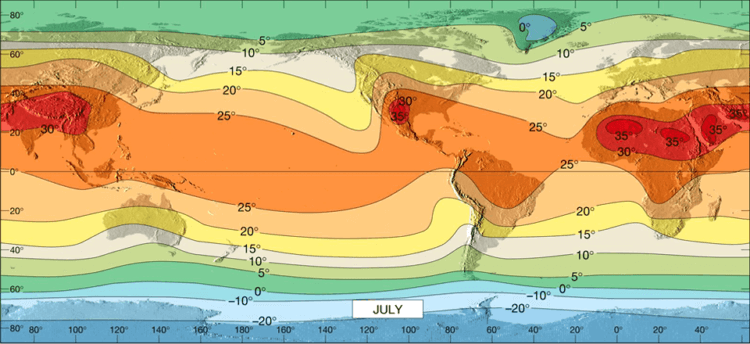 In the previous articles in the Geography section, we have discussed in detail about the composition and structure of the earth’s atmosphere, how and from where the earth receives its energy, how the earth maintains its temperature, methods through which the heat energy gets transferred in the atmosphere (insolation and heat balance of the earth) etc.
In the previous articles in the Geography section, we have discussed in detail about the composition and structure of the earth’s atmosphere, how and from where the earth receives its energy, how the earth maintains its temperature, methods through which the heat energy gets transferred in the atmosphere (insolation and heat balance of the earth) etc.
In this article, we are going to discuss the trend of distribution of temperature in the earth’s atmosphere.
Difference between heat and temperature
- The interaction of incoming solar radiation (insolation) with the atmosphere and the earth’s surface creates heat. This is measured in terms of temperature.
- While heat represents the molecular movement of particles comprising a substance, the temperature is the measurement in degrees of how hot (or cold) a thing (or a place) is.
- So, heat is the energy which makes things or objects hot, while temperature measures the intensity of heat (degree of hotness/coldness).
- Heat and temperature are closely related to each other because gain or loss of heat is necessary to raise or lower the temperature.
- The Celsius scale is the internationally accepted scale for reporting air temperature.
- Fahrenheit scale and Kelvin scales are other scales used to measure temperature.
- The Fahrenheit temperature scale is based on 32 °F for the freezing point of water and 212 °F for the boiling point of water, with the interval between the two being divided into 180 parts.
- On the Kelvin scale, 0 K represents absolute zero (-273 °C), the temperature at which the molecules of a substance have their lowest possible energy.

Distribution of Temperature
Distribution of temperature varies both horizontally and vertically. Let us study it under
- A) Horizontal Distribution of Temperature
- B) Vertical Distribution of Temperature
Also read: Heat Index
A) Horizontal Distribution of Temperature
- Distribution of temperature across the latitudes over the surface of the earth is called its horizontal distribution.
- On maps, the horizontal distribution of temperature is commonly shown by isotherms.
- Isotherms are line connecting points that have an equal temperature.

- When we analyse an isotherm map, it can be seen that the horizontal distribution of temperature is uneven.
The factors responsible for the uneven horizontal distribution of temperature are:
Latitude
- In the previous article, we have studied that the angle of incidence of sun’s rays goes on decreasing from the equator towards the poles.
- Higher the angle of incidence, higher is the temperature. Similarly, lower the angle of incidence, lower is the temperature.
- This is why the temperature is higher near the tropical regions and decreases towards the poles.
Altitude
- As we all know, the temperature in the troposphere goes on decreasing with increase in height.
- Temperature decreases at an average rate of nearly 6 degree Celsius per 1000 m altitude, which is known as Normal Lapse Rate.
Land and Sea Contrast
- Compared to land, the sea gets heated slowly and loses heat slowly. Land heats up and cools down quickly.
- As a result, the temperature is relatively higher on land during day time and it is higher in water during the night.
- Also, the places situated near the sea come under the moderating influence of the sea and land breezes which moderates the temperature.
- There are also seasonal variations in the temperature of land and sea. During summer, the air above land has a higher temperature than the oceans. But the air above oceans gets higher temperature than landmass in winter.
- Notwithstanding the great contrast between land and water surfaces, there are differences in the rate of heating of different land surfaces. A snow-covered land as in polar areas warms very slowly because of a large amount of reflection of solar energy. A vegetation covered land does not get excessively heated because a great amount of insolation is used in evaporating water from the plants.
Ocean Currents
- Ocean Currents are of two types – warm and cold.
- Warm currents make the coasts along which they flow warmer, while cold currents reduce the temperature of the coasts along which they flow.
- The North-Western European Coasts do not freeze in winter due to the effect of North Atlantic Drift (a warm current), while the Quebec on the coast of Canada is frozen due to the Cold Labrador Current flowing along it, though the Quebec is situated in lower latitudes than the North-West European Coast.

Air Masses
- Like the land and sea breezes, the passage of air masses also affects the temperature.
- The places, which come under the influence of warm air masses experience higher temperature and the places that come under the influence of cold air masses experience low temperature.
Vegetation Cover
- Soil devoid of vegetation cover receives heat more rapidly than the soil under vegetation cover. Because vegetation cover absorbs much of sun’s heat and then prevents quick radiation from the earth whereas the former radiates it more rapidly.
- Hence the temperature variations in densely forested areas are lower than those in desert areas.
Note: Along with these, the other factors which are responsible for the uneven horizontal distribution of temperature are winds, nature of the soil, slope and aspect of the surface, relief features, etc.
- The horizontal distribution of temperature over the globe can be studied easily from the isotherm maps of January and July months since the seasonal extremes of high and low temperature are most obvious in both northern and southern hemispheres during these months.
Horizontal Distribution of Temperature in January
- In January, the sun shines vertically overhead near the tropic of Capricorn. Hence, it is summer in southern hemisphere and winter in the northern hemisphere.
- A high temperature is found over the landmasses mainly in three regions of the southern hemisphere. These regions are North-West Argentina, East and Central Africa, and Central Australia.
- Isotherm of 30°C closes them.

- In the northern hemisphere, landmasses are cooler than the oceans. As the air is warmer over the oceans than over landmasses in the northern hemisphere, the isotherms bend towards the north (poles) when they cross the oceans and to the south (equator) over the continents.
- This can be clearly visible over the North Atlantic Oceans. The presence of warms ocean currents (Gulf Stream and North Atlantic Drift) make the Northern Atlantic Ocean warmer and the isotherms bend towards the poles. Over the land, the temperature decreases sharply and the isotherms bend towards the equator in Europe.
- In the southern hemisphere, the effect of the oceans is well pronounced (due to few landmasses).
- Here, the isotherms are more or less parallel to the latitudes and the variation in temperature is more gradual than in the northern hemisphere.
Horizontal Distribution of Temperature in July
- In July, the sun shines vertically overhead near the Tropic of cancer. Hence, high temperatures are found in the entire northern hemisphere.
- The regions having high temperature include South Western USA, the Sahara, the Arabia, Iraq, Iran, Afghanistan, desert region of India and China.
- However, the lowest temperature of 0°C is also noticed in the Northern Hemisphere during summer in the central part of Greenland.

- During summer in the northern hemisphere, isotherms bend towards the equator while crossing oceans and towards the poles while crossing landmasses.
- Isotherms are wide spaced over oceans while they are closely spaced over landmasses.
- In July, the deviation of isotherms is not that much pronounced as in January.
B) Vertical Distribution of Temperature
- We have already studied that the temperature in the troposphere decreases with an increase in the altitude.
- This vertical gradient of temperature is commonly referred to as the standard atmosphere or Normal Lapse Rate.
- However, this normal lapse rate varies with height, season, latitude and other factors.
- Indeed the actual lapse rate of temperature does not always show a decrease with altitude.
Inversion of Temperature
- The phenomenon in which temperature increases with increasing altitude temporarily and locally under certain conditions is known as inversion of temperature.
- Inversion is usually of short duration but quite common nonetheless.
- Long winter night, clear sky, dry air and absence of winds leads to quick radiation of heat from the earth’s surface, as well as from the lower layers of the atmosphere.
- This results in the cooling of the air near the earth’s surface. The upper layers which lose their heat not so quickly are comparatively warm.
- Hence the normal condition, in which temperature decreases with increasing height, is reversed. The cooler air is nearer the earth and the warmer air is aloft.
- In other words, temperature increases with increasing height temporarily or locally.
- The phenomenon of inversion of temperature is mostly observed in intermontane valleys due to air drainage.
- During winters the mountain slopes cool very rapidly due to the quick radiation of heat.
- The air resting above them also becomes cold and its density increases. Hence, it moves down the slopes and settles down in the valleys.
- This air pushes the comparatively warmer air of valleys upwards and leads to the phenomenon of inversion of temperature.
- Sometimes the temperature falls below freezing point in the valleys leading even to the occurrence of frost. In contrast, the higher slopes remain comparatively warmer.
- This movement of heavy and dense cold air towards the valley slopes almost like water is termed as air drainage.
Article by: Jijo Sudarshan.





– why is deviation of isotherm more pronounced in jan than in july?
Because,
In January – it’s winter in northern hemisphere, majorly occupied by land. It’s a given that temperatures on land see a significant variation compared to water. Hence, the deviation of the isotherms in northern hemisphere is large.
Very nice answer. Easily understandable…. Thank you very much…
Thank you good morning sir nice article
Thanks
Thanks !
Thanks you sir good articles